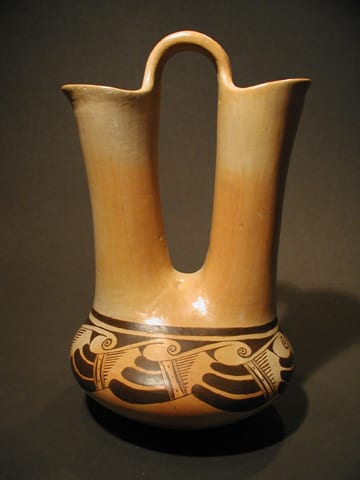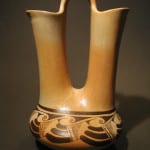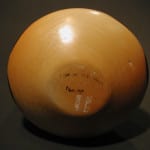Hopi-Tewa wedding vase is signed “Dextra M. Quotskuyva Nampeyo.” According to Marti Struever (2001:120, FN#1), “Until 1998 Dextra’s pottery signature was always painted, evolving from ‘Dextra Quotskuyva Nampeyo’ in the 1960s and early 1970s to ‘Dextra Quotskuyva’, then ‘Dextra Q’ and finally ‘Dextra.” Commenting on a pot made in 1972, Struever writes “This pot is dated and signed “Dextra Quotskuyva Nampeyo,” a signature which Dextra used for only a few years early in her career” (2001:89).
When purchased, one of the spouts had a missing rim, which was repaired by Andy Goldschmidt. Andy repaired only the rim, but in conversation pointed out to me that parts of the pot had been repainted by some prior restorer. Since the painting seems quite bright in contrast to the somewhat faded signature, I suspect that Andy is correct. In short, this is an imperfect example of Dextra’s work, but one that I could afford.
Because of her extraordinary technical skill, willingness to experiment with new designs, her dedication to teaching younger generations of potters (see Struever, 2001), and early promotion by Struever and other dealers, Dextra is unquestionably the matriarch of Hopi-Tewa potters od her generation. If the artistic gifts of the “Old Lady” were clearly passed on to her daughter Annie, then Annie surly passed them through her talented daughter Rachel to great-granddaughter Dextra. Struever’s description of Dextra’s work as “Painted Perfection” seems to me to be exactly correct.
The art world embraced the “Dextra School” of pottery as “real art” and absorbed it fully into the Santa Fe art world. (See Dextra’s kind memorial to Rick Dillingham in Struever, 2001:17.) According to Struever, Dextra’s mother Rachel encouraged her to paint the “Old Lady” designs that had become a trademark of her family. “As a respectful daughter she followed those suggestions until late in the 1970s, near the end of her mother’s life” (2001:18). (Dextra’s mother died in 1985.)
In spite of the physical imperfections of 1998-03, I think I am attracted the pot because it carries this earlier “Nampeyo family” design. The painting of 1998-03 is simple, fits the pot well, and highlights the fine blushing and shape of the vessel. (I think Dextra would judge this a “female” pot; see Struever, 2001:81.) So traditional am I that I am not particularly attracted to the ubiquitous “wedding vase” shape made in every pottery pueblo because it sells well to tourists but which has historical precedent only in Santa Clara. I have resisted buying wedding vases because they are not a Hopi form, but the simple beauty of this pot by Dextra overwhelmed that sentiment. For additional biographical information about Dextra, see the Blair’s book (1999:186-194). There are only three other wedding vases in the collection: 2010-04, 2015-06 and 2020-01. All have exceptional decoration.
After her mother’s death, Dextra began a long career of experimentation and her “painted perfection” became the standard for a generation of Hopi/Tewa potters, many of them male. See Struever, 2001 for a retrospective of Dextra’s oeuvre.
For a pot done at the height of her career, see 2010-21 in this collection.




